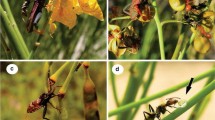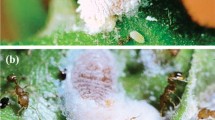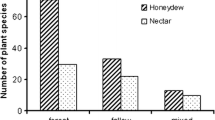Abstract
The pioneer tree Macaranga in SE Asia has developed manyfold associations with ants. The genus comprises all stages of interaction with ants, from facultative relationships to obligate myrmecophytes. Only myrmecophytic Macaranga offer nesting space for ants and are associated with a specific ant partner. The nonmyrmecophytic species are visited by a variety of different ant species which are attracted by extrafloral nectaries (EFN) and food bodies. Transitional Macaranga species like M. hosei are colonized later in their development due to their stem structure. Before the colonization by their specific Crematogaster partner the young plants are visited by different ant species attracted by EFN. These nectaries are reduced and food body production starts as soon as colonization becomes possible. We demonstrated earlier that obligate ant partners can protect their Macaranga plants against herbivore damage and vine cover. In this study we focused on nonspecific interactions and studied M. tanarius and M. hosei, representing a non-myrmecophyte and a transitional species respectively. In ant exclusion experiments both M. tanarius and M. hosei suffered significantly higher mean leaf damage than controls, 37% versus 6% in M. hosei, 16% versus 7% in M. tanarius. M. tanarius offers both EFN and food bodies so that tests for different effects of these two food rewards could be conducted. Plants with food bodies removed but with EFN remaining had the lowest mean increase of herbivore damage of all experimental groups. Main herbivores on M. hosei were mites and caterpillars. Many M. tanarius plants were infested by a shootborer. Both Macaranga species were visited by various ant species, Crematogaster spp. being the most abundant. We found no evidence for any specific relationships. The results of this study strongly support the hypothesis that non-specific, facultative associations with ants can be advantageous for Macaranga plants. Food bodies appear to have lower attractive value for opportunistic ants than EFN and may require a specific dietary adaptation. This is also indicated by the fact that food body production in the transitional M. hosei does not start before stem structure allows a colonization by the obligate Crematogaster species. M. hosei thus benefits from facultative association with a variety of ants until it produces its first domatia and can be colonized by its obligate mutualist.
Similar content being viewed by others
References
Beattie AJ (1985) The evolutionary ecology of ant-plant mutualisms. Cambridge University Press, Cambridge
Davidson DW, Foster RB, Snelling RR, Lozada PW (1991) Variable composition of some tropical ant-plant symbioses. In: Price PW (ed) Herbivory: tropical and temperate perspectives. Wiley, New York, pp 145–162
Fiala B (1991) Partnerschaften von Pflanzen und Ameisen. Biologie Unserer Zeit 5:241–247
Fiala B, Maschwitz U (1990) Studies on the South East Asian ant-plant association Crematogaster borneensis/Macaranga: adaptations of the ant partner. Insectes Soc 37:212–231
Fiala B, Maschwitz U (1991) Extrafloral nectaries in the genus Macaranga (Euphorbiaceae) in Malaysia: comparative studies of their possible significance as predispositions for myrmecophytism. Biol J Linn Soc 44:287–305
Fiala B, Maschwitz U (1992a) Food bodies and their significance for obligate ant-association in the tree genus Macaranga (Euphorbiaceae). Bot J Linn Soc 110:61–75
Fiala B, Maschwitz U (1992b) Domatia as most important adaptations in the evolution of myrmecophytes in the paleotropical tree genus Macaranga (Euphorbiaceae). Plant Syst Evol 180:53–64
Fiala B, Maschwitz U, Tho YP, Helbig AJ (1989) Studies of a South East Asian ant-plant association: protection of Macaranga trees by Crematogaster borneensis. Oecologia 79:463–470
Fiala B, Maschwitz U, Tho YP (1991) The association between Macaranga and ants in South East Asia. In: Huxley C, Cutler DF (eds) Interactions between ants and plants. Oxford University Press, Oxford, pp 263–270
Huxley CR (1986) Evolution of benevolent ant-plant relationships. In: Juniper B, Southwood R (eds) Insects and the plant surface. Arnold, London, pp 257–282
Jones TH, Blum MS, Andersen AN, Fales HM, Escoubas P (1988) Novel 2-ethyl-5-alkylpyrrolidines in the venom of an Australian ant of the genus Monomorium. J Chem Ecol 14:35–45
Keeler KH (1989) Ant-plant interactions. In: Abrahamson WG (ed) Plant-animal interactions. McGraw-Hill, New York, pp 207–242
Koptur S (1979) Facultative mutualism between weedy vetches bearing extrafloral nectaries and weedy ants in California. Am J Bot 66:1016–1020
Koptur S (1992) Extrafloral nectary-mediated interactions between insects and plants. In: Bernays E (ed) Insect-plant interactions, vol IV. CRC Press, Boca Raton, pp 82–129
Letourneau DK, Feynner AG, Jebb M (1993) Coping with enemyfilled space: herbivores on Endospermum in Papua New Guinea. Biotropica 25:95–99
Mackay DA, Whalen MA (1991) Some associations between ants and euphorbs in tropical Australasia. In: Huxley C, Cutler DF (eds) Interactions between ants and plants. Oxford University Press, Oxford, pp 238–249
McKey D (1988) Promising new directions in the study of antplant mutualisms. In: Greuter W, Zimmer B (eds) Proc Int Bot Congr XIV. Koeltz, Koenigstein, pp 335–355
Oliviera PS, Brandão CRF (1991) The ant community associated with extrafloral nectaries in the Brazilian cerrados. In: Huxley CR, Cutler DF (eds) Ant-plant interactions. Oxford University Press, Oxford, pp 198–212
Schupp EW (1986) Azteca protection of Cecropia: ant occupation benefits juvenile trees. Oecologia 70:379–385
Vasconcelos HL (1991) Mutualism between Maieta guianensis Aubl., a myrmecophyte melastome, and one of its ant inhabitants: ant protection against insect herbivores. Oecologia 87:295–298
Whalen MA, Mackay DA (1988) Patterns of ant and herbivore activity on five understory euphorbiaceous saplings in submontane Papua New Guinea. Biotropica 20:294–300
Author information
Authors and Affiliations
Rights and permissions
About this article
Cite this article
Fiala, B., Grunsky, H., Maschwitz, U. et al. Diversity of ant-plant interactions: protective efficacy in Macaranga species with different degrees of ant association. Oecologia 97, 186–192 (1994). https://doi.org/10.1007/BF00323148
Received:
Accepted:
Issue Date:
DOI: https://doi.org/10.1007/BF00323148




